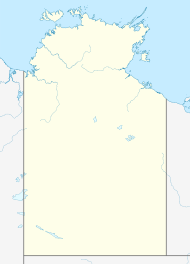Umbakumba, Northern Territory facts for kids
Quick facts for kids UmbakumbaNorthern Territory |
|
|---|---|
| Region | East Arnhem Region |
| Territory electorate(s) | Arnhem |
| Federal Division(s) | Lingiari |
Umbakumba is a community found on Groote Eylandt. This island is located in the Gulf of Carpentaria in the Northern Territory, Australia.
The main languages spoken here are Anindilyakwa, which is an Australian Aboriginal language, and English. Some people also speak Yolŋu Matha languages.
Umbakumba is one of the three main towns on the Groote Eylandt islands. The other two are Milyakburra and Angurugu. In these places, Anindilyakwa is the most common language. In 2016, the population of Umbakumba was 503 people.
Contents
History of Umbakumba
Early Visitors: Macassan Sailors
Long before Europeans arrived, sailors from a place called Macassar (now part of Indonesia) and Bugis people visited this area. They came looking for a sea creature called trepang (sea cucumber) from the early 1700s.
These visitors brought new things, like tamarind fruit, chilli, and even beer. Their trading continued until 1906, when the Australian Government changed its rules about who could enter the country.
You can still see signs of the Macassan visitors today. For example, there are wild tamarind trees that they brought to the area. Even the name Umbakumba comes from a Malay word, ombak-ombak, which means ‘lapping of waves’.
European Settlement Begins
Fred Gray's Settlement
A man named Fred H. Gray, who traded in pearls and trepang, started the Umbakumba Native Settlement. He set it up on an old Macassan trading spot.
Mr. Gray used this settlement as a base for collecting trepang. He hired many local Aboriginal people to help him in the 1920s and 1930s.
In 1938, Umbakumba became famous as a place where Qantas Empire Airways flying boats could stop and refuel. These planes flew long distances between Sydney, Singapore, and the south of England. During World War II, this base was used by the Royal Australian Air Force.
The Church Mission Society (CMS), which ran the Angurugu Mission on the other side of the island, did not agree with how Gray ran his settlement. When the CMS stopped supporting Gray's settlement, he decided to keep his work going.
In 1956, the government decided that only missions run by official Christian groups would get support. This meant private people like Fred Gray would not. So, the government stopped paying money to his settlement.
The Church Mission Society Takes Over
The Church Mission Society officially took over running the settlement on February 17, 1958. Keith Hart became the new leader. CMS then renamed it Umbakumba Mission. By the middle of 1959, the number of Aboriginal people living there had grown to 175.
In 1966, the Welfare Branch of the Northern Territory government took over the mission. This happened because there were not enough staff to run it. At that time, 214 people lived in Umbakumba.
Umbakumba Today
The government later gave control of the town to a self-governing Aboriginal Community Council in 1973. In 2008, Umbakumba became part of the East Arnhem Shire Council.
People of Umbakumba
Population Details
The 2016 Australian Census showed that 503 people lived in Umbakumba. About 95.6% of these people were Aboriginal and/or Torres Strait Islander. The average age of people in Umbakumba was 25 years old.
Traditional Owners
The Mamarika Clan are the traditional owners of the land where Umbakumba is located. Groote Eylandt has 14 different clan groups among its Aboriginal people. These clans belong to two main groups called moieties.
Umbakumba is one of the three main towns on Groote Eylandt where the Anindilyakwa language is spoken most often at home. The other towns are Milyakburra and Angurugu. The clans keep their traditions strong and have close connections with people in the community of Numbulwar and on Bickerton Island.


